- List of Theories
- Privacy Policy
- Opt-out preferences

Types of Speech in Communication
Communication is a fundamental aspect of human interaction, and speech is one of its most powerful tools. Speech allows individuals to convey ideas, emotions, intentions, and information effectively. Different types of speech are used depending on the context, audience, and purpose of communication. Understanding these types helps in selecting the appropriate mode of expression and achieving the desired impact.
1. Informative Speech
Informative speech educates or informs the audience about a particular topic. The primary goal is to provide knowledge, explain concepts, or clarify issues. This type of speech is often used in educational settings, professional presentations, or public lectures.
Example: A professor giving a lecture on the impacts of climate change is delivering an informative speech. The professor provides data, explains scientific concepts, and discusses potential solutions to the problem. The focus is on sharing factual information to enhance the audience’s understanding.
2. Persuasive Speech
Persuasive speech aims to convince the audience to adopt a certain viewpoint or take a specific action. The speaker uses logical arguments, emotional appeals, and credible evidence to influence the audience’s beliefs, attitudes, or behaviors. Persuasive speeches are common in political campaigns, advertising, and debates.
Example: A politician giving a campaign speech will likely use persuasion to garner support. They might highlight their achievements, present their future plans and appeal to the emotions of the audience by addressing pressing societal issues. The objective is to persuade the audience to vote for them.
3. Demonstrative Speech
Demonstrative speech involves showing the audience how to do something. It combines explanation with practical demonstration, making it easier for the audience to understand and replicate the process. This type of speech is useful in workshops, training sessions, and instructional videos.
Example: A chef giving a cooking class is engaging in demonstrative speech. They not only explain the recipe but also demonstrate each step, such as chopping vegetables, mixing ingredients, and cooking the dish. The audience learns by watching and can follow along.
4. Entertaining Speech
Entertaining speech is intended to amuse the audience and provide enjoyment. While it may contain informative or persuasive elements, its primary purpose is to entertain. This type of speech is often light-hearted, humorous, and engaging, making it suitable for social events, ceremonies, or entertainment shows.
Example: A stand-up comedian performing a routine uses an entertaining speech to make the audience laugh. The comedian may share funny anecdotes, joke about everyday situations, or use witty observations to entertain the crowd. The focus is on creating an enjoyable experience.
5. Special Occasion Speech
Special occasion speech is delivered during specific events or ceremonies, such as weddings, graduations, funerals, or award ceremonies. The content is often personalized and tailored to the occasion, focusing on the significance of the event and the emotions associated with it.
Example: During a wedding, the best man might give a special occasion speech to honor the couple. The speech might include heartfelt memories, humorous stories, and well-wishes for the future. The purpose is to celebrate the occasion and express support for the couple.
6. Impromptu Speech
An impromptu speech is delivered without preparation, often in response to an unexpected situation or question. It requires quick thinking and the ability to articulate thoughts clearly on the spot. This type of speech is common in casual conversations, interviews, or meetings.
Example: In a team meeting, an employee might be asked to give an impromptu speech about the progress of a project. Without prior notice, the employee summarizes the project’s status, highlights key achievements, and addresses any challenges. The speech is spontaneous and unscripted.
7. Extemporaneous Speech
Extemporaneous speech is prepared in advance but delivered without a script. The speaker has a general outline or notes but speaks more freely, allowing for natural delivery and adaptability. This type of speech is common in business presentations, academic conferences, and public speaking engagements.
Example: A business executive presenting a quarterly report to stakeholders might use extemporaneous speech. They have prepared key points and data but speak conversationally, adjusting their delivery based on the audience’s reactions and questions. This approach allows for a more engaging and dynamic presentation.
8. Manuscript Speech
Manuscript speech is read word-for-word from a prepared text. This type of speech is often used when precise wording is essential, such as in official statements, legal proceedings, or news broadcasts. The speaker focuses on delivering the content accurately without deviation.
Example: A news anchor reading the evening news is using manuscript speech. The anchor reads from a teleprompter, ensuring that the information is conveyed accurately and clearly. The emphasis is on precision and professionalism.
9. Memorized Speech
Memorized speech involves delivering a speech from memory, without notes or a script. This approach is often used in performances, speeches that require exact wording, or competitive speaking events. Memorization allows for a polished and confident delivery but requires extensive practice.
Example: An actor reciting a monologue in a play is giving a memorized speech. The actor has committed the lines to memory and delivers them with emotion and expression, engaging the audience fully. The speech is fluid and rehearsed, showcasing the actor’s skill.
10. Motivational Speech
Motivational speech is designed to inspire and energize the audience, often encouraging them to pursue their goals or overcome challenges. The speaker uses personal stories, powerful messages, and emotional appeals to uplift the audience and provoke action.
Motivational speeches are common in self-help seminars, leadership conferences, and personal development events.
Example: A life coach speaking to a group of entrepreneurs might give a motivational speech about resilience and perseverance. The coach shares personal experiences of overcoming obstacles and encourages the audience to stay focused on their goals, despite setbacks.
11. Pitch Speech
A pitch speech is a brief, persuasive speech used to present an idea, product, or proposal to an audience, usually with the aim of securing funding, approval, or support. The speaker must be concise, clear, and convincing, often focusing on the benefits and potential impact of the proposal.
Example: An entrepreneur pitching his startup idea to potential investors is giving a pitch speech. The entrepreneur outlines the problem their product solves, the market opportunity, and how the investors will benefit, all within a few minutes.
A eulogy is a speech delivered at a funeral or memorial service, honoring the life and legacy of a deceased person. The speaker reflects on the person’s character, achievements, and the impact they had on others, often blending personal anecdotes with expressions of gratitude and remembrance.
Example: A family member delivering a eulogy at a funeral might share touching stories about the deceased, highlighting their kindness, generosity, and love for their family. The eulogy serves as a tribute, celebrating the life of the person who has passed away.
Tips for Giving a Great Speech
1. Know Your Audience : Understanding your audience’s interests, values, and expectations helps tailor your message effectively.
2. Structure Your Speech: Organize your content with a clear introduction, body, and conclusion. A well-structured speech is easier to follow and more impactful.
3. Practice: Rehearse your speech multiple times to become familiar with the content and improve your delivery.
Rehearse your speech alone or in front of your friends (maybe in low numbers) to become familiar with the vocabulary and pronunciation of the precise phrases. so you can control the speed and improve your speech delivery.
4. Use Visual Aids: Visual aids can enhance understanding and retention. Ensure they are relevant and not overly distracting.
5. Engage with the Audience: Make eye contact, use gestures, and involve the audience through questions or interactive elements to keep them engaged.
How to Make Your Speech More Memorable
1. Start with a Strong Opening: Capture attention with a powerful quote, anecdote, or question that relates to your main message.
2. Use Stories: People remember stories better than facts alone. Incorporate personal or relatable stories to illustrate your points.
3. Be Passionate: Express enthusiasm and passion for your topic. A passionate delivery can leave a lasting impression.
4. Repeat Key Points: Repetition helps reinforce important ideas. Summarize key points at the end of your speech to ensure they stick.
5. End with a Call to Action: Encourage your audience to take a specific action or reflect on your message. A clear and compelling conclusion makes your speech memorable.
Related Posts:
- Non-Verbal Communication
- Various Types Of Communication Styles - Examples
- Journalism - Definition, Types and Examples
- Types Of Thinking-Tips And Tricks To Improve Thinking Skill
- Conflict Management - Skills, Styles And Models
- Types of Communication Theories - Briefly Explained
Leave a Comment
Next post: Burke’s Dramatism Theory
Previous post: Bloom’s Taxonomy | Domains of Learning with Examples
- Advertising, Public relations, Marketing and Consumer Behavior
- Business Communication
- Communication / General
- Communication Barriers
- Communication in Practice
- Communication Models
- Cultural Communication
- Development Communication
- Group Communication
- Intercultural Communication
- Interpersonal Communication
- Mass Communication
- Organisational Communication
- Political Communication
- Psychology, Behavioral And Social Science
- Technical Communication
- Visual Communication
Communication Theory
- Games, topic printables & more
- The 4 main speech types
- Example speeches
- Commemorative
- Declamation
- Demonstration
- Informative
- Introduction
- Student Council
- Speech topics
- Poems to read aloud
- How to write a speech
- Using props/visual aids
- Acute anxiety help
- Breathing exercises
- Letting go - free e-course
- Using self-hypnosis
- Delivery overview
- 4 modes of delivery
- How to make cue cards
- How to read a speech
- 9 vocal aspects
- Vocal variety
- Diction/articulation
- Pronunciation
- Speaking rate
- How to use pauses
- Eye contact
- Body language
- Voice image
- Voice health
- Public speaking activities and games
- Blogging Aloud
- About me/contact
- Types of speeches
The 4 types of speeches in public speaking
Informative, demonstrative, persuasive and special occasion.
By: Susan Dugdale
There are four main types of speeches or types of public speaking.
- Demonstrative
- Special occasion or Entertaining
To harness their power a speaker needs to be proficient in all of them: to understand which speech type to use when, and how to use it for maximum effectiveness.
What's on this page:
An overview of each speech type, how it's used, writing guidelines and speech examples:
- informative
- demonstrative
- special occasion/entertaining
- how, and why, speech types overlap
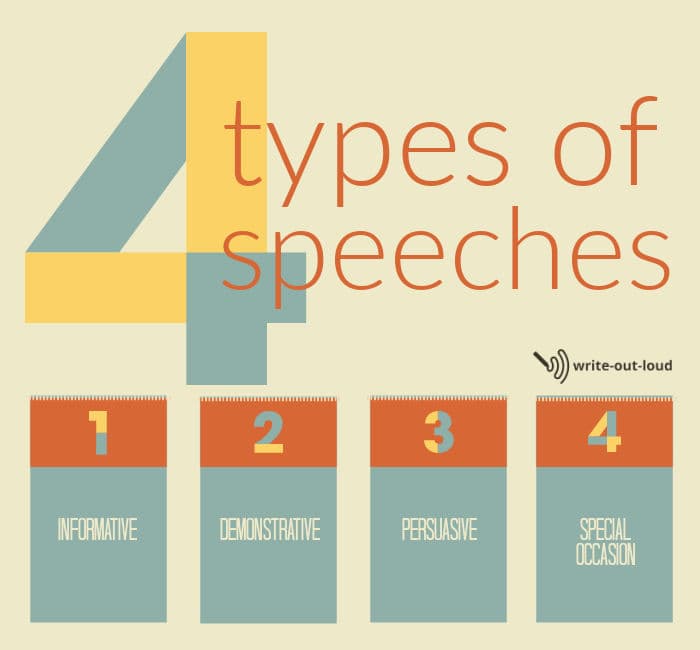
Return to Top
Informative speeches
An informative speech does as its name suggests: informs. It provides information about a topic. The topic could be a place, a person, an animal, a plant, an object, an event, or a process.
The informative speech is primarily explanatory and educational.
Its purpose is not to persuade or influence opinion one way or the other. It is to provide sufficient relevant material, (with references to verifiable facts, accounts, studies and/or statistics), for the audience to have learned something.
What they think, feel, or do about the information after they've learned it, is up to them.
This type of speech is frequently used for giving reports, lectures and, sometimes for training purposes.
Examples of informative speech topics:
- the number, price and type of dwellings that have sold in a particular suburb over the last 3 months
- the history of the tooth brush
- how trees improves air quality in urban areas
- a brief biography of Bob Dylan
- the main characteristics of Maine Coon cats
- the 1945 US bombing of Hiroshima and Nagasaki
- the number of, and the work of local philanthropic institutions
- the weather over the summer months
- the history of companion planting
- how to set up a new password
- how to work a washing machine
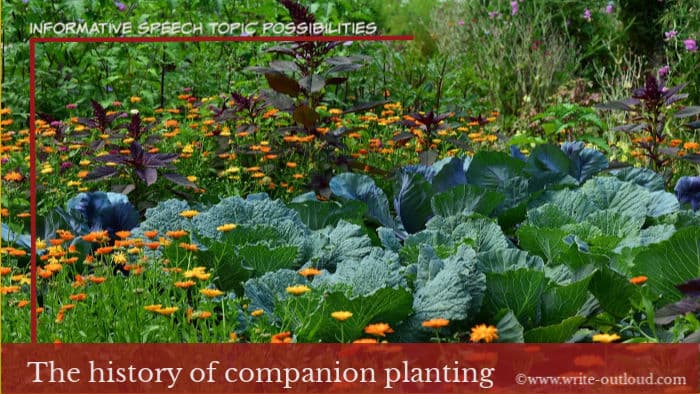
Click this link if you'd like more informative topic suggestions . You'll find hundreds of them.
And this link to find out more about the 4 types of informative speeches : definition, description, demonstration and explanation. (Each with an example outline and topic suggestions.)
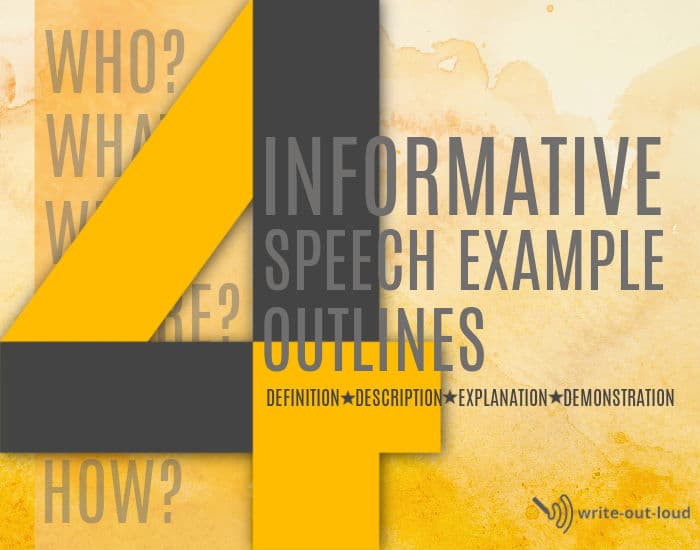
Demonstration, demonstrative or 'how to' speeches
A demonstration speech is an extension of an informative process speech. It's a 'how to' speech, combining informing with demonstrating.
The topic process, (what the speech is about), could either be demonstrated live or shown using visual aids.
The goal of a demonstrative speech is to teach a complete process step by step.
It's found everywhere, all over the world: in corporate and vocational training rooms, school classrooms, university lecture theatres, homes, cafes... anywhere where people are either refreshing or updating their skills. Or learning new ones.
Knowing to how give a good demonstration or 'how to' speech is a very valuable skill to have, one appreciated by everybody.
Examples of 'how to' speech topics are:
- how to braid long hair
- how to change a car tire
- how to fold table napkins
- how to use the Heimlich maneuver
- how to apply for a Federal grant
- how to fill out a voting form
- how to deal with customer complaints
- how to close a sale
- how to give medicine to your cat without being scratched to bits!
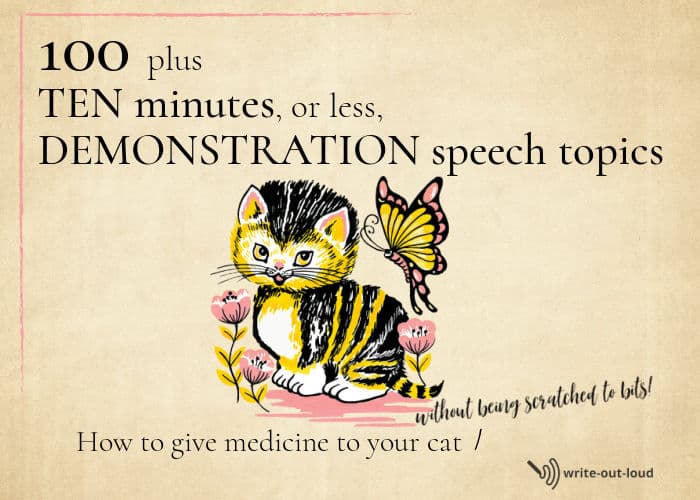
Resources for demonstration speeches
1 . How to write a demonstration speech Guidelines and suggestions covering:
- choosing the best topic : one aligning with your own interests, the audience's, the setting for the speech and the time available to you
- how to plan, prepare and deliver your speech - step by step guidelines for sequencing and organizing your material plus a printable blank demonstration speech outline for you to download and complete
- suggestions to help with delivery and rehearsal . Demonstration speeches can so easily lurch sideways into embarrassment. For example: forgetting a step while demonstrating a cake recipe which means it won't turn out as you want it to. Or not checking you've got everything you need to deliver your speech at the venue and finding out too late, the very public and hard way, that the lead on your laptop will not reach the only available wall socket. Result. You cannot show your images.
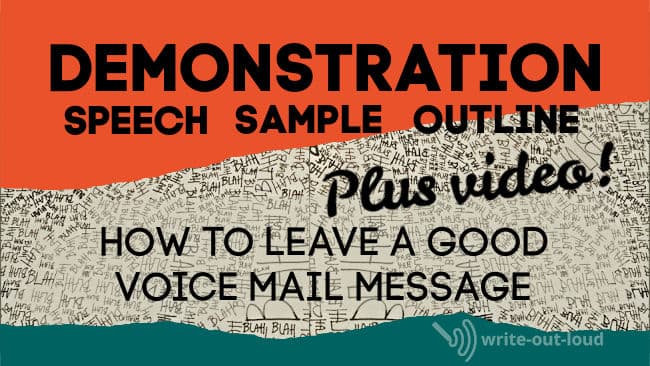
2. Demonstration speech sample outline This is a fully completed outline of a demonstration speech. The topic is 'how to leave an effective voice mail message' and the sample covers the entire step by step sequence needed to do that.
There's a blank printable version of the outline template to download if you wish and a YouTube link to a recording of the speech.
3. Demonstration speech topics 4 pages of 'how to' speech topic suggestions, all of them suitable for middle school and up.

Persuasive speeches
The goal of a persuasive speech is to convince an audience to accept, or at the very least listen to and consider, the speaker's point of view.
To be successful the speaker must skillfully blend information about the topic, their opinion, reasons to support it and their desired course of action, with an understanding of how best to reach their audience.
Everyday examples of persuasive speeches
Common usages of persuasive speeches are:
- what we say when being interviewed for a job
- presenting a sales pitch to a customer
- political speeches - politicians lobbying for votes,
- values or issue driven speeches e.g., a call to boycott a product on particular grounds, a call to support varying human rights issues: the right to have an abortion, the right to vote, the right to breathe clean air, the right to have access to affordable housing and, so on.
Models of the persuasive process
The most frequently cited model we have for effective persuasion is thousands of years old. Aristotle, the Greek philosopher, 384–322 BC , explained it as being supported by three pillars: ethos, pathos and logos.
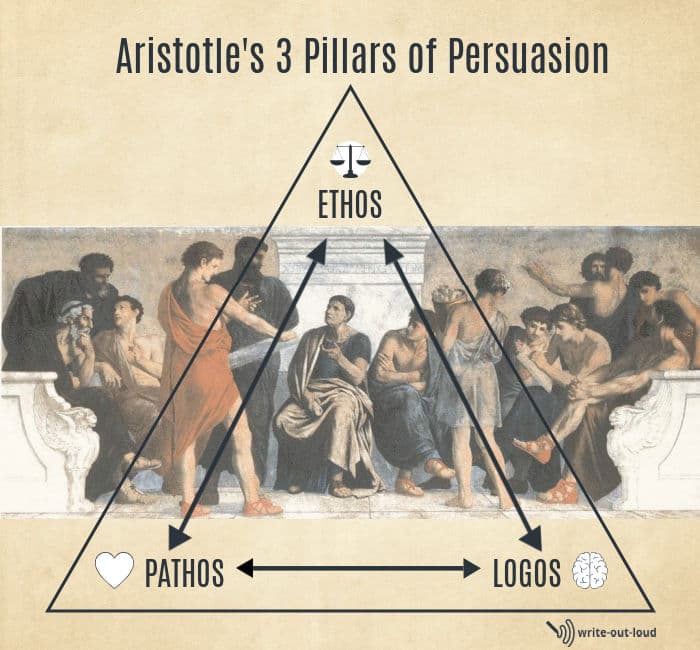
Briefly, ethos is the reliability and credibility of the speaker. How qualified or experienced are they talk on the topic? Are they trustworthy? Should we believe them? Why?
Pathos is the passion, emotion or feeling you, the speaker, bring to the topic. It's the choice of language you use to trigger an emotional connection linking yourself, your topic and the audience together, in a way that supports your speech purpose.
(We see the echo of Pathos in words like empathy: the ability to understand and share the feels of another, or pathetic: to arouse feelings of pity through being vulnerable and sad.)
Logos is related to logic. Is the information we are being presented logical and rational? Is it verifiable? How is it supported? By studies, by articles, by endorsement from suitably qualified and recognized people?
To successfully persuade all three are needed. For more please see this excellent article: Ethos, Pathos, Logos: 3 Pillars of Public Speaking and Persuasion
Monroe's Motivated Sequence of persuasion
Another much more recent model is Monroe's Motivated Sequence based on the psychology of persuasion.
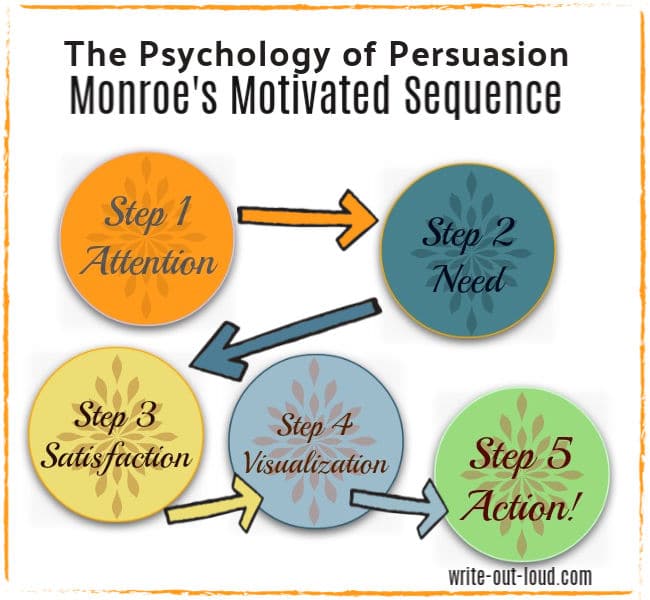
It consists of five consecutive steps: attention, need, satisfaction, visualization and action and was developed in the 1930s by American Alan H Monroe, a lecturer in communications at Purdue University. The pattern is used extensively in advertising, social welfare and health campaigns.
Resources for persuasive speeches
1. How to write a persuasive speech Step by step guidelines covering:
- speech topic selection
- setting speech goals
- audience analysis
- empathy and evidence
- balance and obstacles
- 4 structural patterns to choose from
2. A persuasive speech sample outline using Monroe's Motivated Sequence
3. An example persuasive speech written using Monroe's Motivated Sequence
4. Persuasive speech topics : 1032+ topic suggestions which includes 105 fun persuasive ideas , like the one below.☺

Special occasion or entertaining speeches
The range of these speeches is vast: from a call 'to say a few words' to delivering a lengthy formal address.
This is the territory where speeches to mark farewells, thanksgiving, awards, birthdays, Christmas, weddings, engagements and anniversaries dwell, along with welcome, introduction and thank you speeches, tributes, eulogies and commencement addresses.
In short, any speech, either impromptu or painstakingly crafted, given to acknowledge a person, an achievement, or an event belongs here.
You'll find preparation guidelines, as well as examples of many special occasion speeches on my site.
Resources for special occasion speeches
How to prepare:
- an acceptance speech , with an example acceptance speech
- a birthday speech , with ongoing links to example 18th, 40th and 50th birthday speeches
- an office party Christmas speech , a template with an example speech
- an engagement party toast , with 5 examples
- a eulogy or funeral speech , with a printable eulogy planner and access to 70+ eulogy examples
- a farewell speech , with an example (a farewell speech to colleagues)
- a golden (50th) wedding anniversary speech , with an example speech from a husband to his wife
- an impromptu speech , techniques and templates for impromptu speaking, examples of one minute impromptu speeches with a printable outline planner, plus impromptu speech topics for practice
- an introduction speech for a guest speaker , with an example
- an introduction speech for yourself , with an example
- a maid of honor speech for your sister , a template, with an example
- a retirement speech , with an example from a teacher leaving to her students and colleagues
- a student council speech , a template, with an example student council president, secretary and treasurer speech
- a Thanksgiving speech , a template, with an example toast
- a thank you speech , a template, with an example speech expressing thanks for an award, also a business thank you speech template
- a tribute (commemorative) speech , with a template and an example speech
- a welcome speech for an event , a template, an example welcome speech for a conference, plus a printable welcome speech planner
- a welcome speech for new comers to a church , a template with an example speech
- a welcome speech for a new member to the family , a template with an example
Speech types often overlap
Because speakers and their speeches are unique, (different content, purposes, and audiences...), the four types often overlap. While a speech is generally based on one principal type it might also have a few of the features belonging to any of the others.
For example, a speech may be mainly informative but to add interest, the speaker has used elements like a demonstration of some sort, persuasive language and the brand of familiar humor common in a special occasion speech where everybody knows each other well.
The result is an informative 'plus' type of speech. A hybrid! It's a speech that could easily be given by a long serving in-house company trainer to introduce and explain a new work process to employees.
Related pages:
- how to write a good speech . This is a thorough step by step walk through, with examples, of the general speech writing process. It's a great place to start if you're new to writing speeches. You'll get an excellent foundation to build on.
- how to plan a speech - an overview of ALL the things that need to be considered before preparing an outline, with examples
- how to outline a speech - an overview, with examples, showing how to structure a speech, with a free printable blank speech outline template to download
- how to make and use cue cards - note cards for extemporaneous speeches
- how to use props (visual aids)
And for those who would like their speeches written for them:
- commission me to write for you
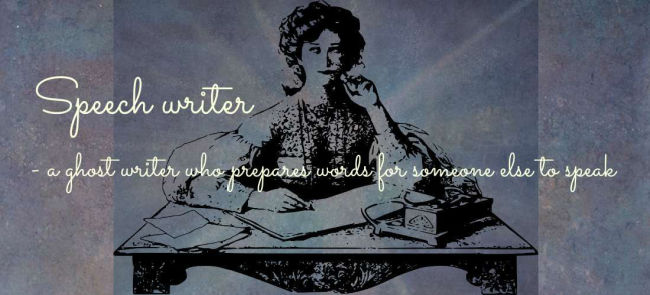
speaking out loud
Subscribe for FREE weekly alerts about what's new For more see speaking out loud

Top 10 popular pages
- Welcome speech
- Demonstration speech topics
- Impromptu speech topic cards
- Thank you quotes
- Impromptu public speaking topics
- Farewell speeches
- Phrases for welcome speeches
- Student council speeches
- Free sample eulogies
From fear to fun in 28 ways
A complete one stop resource to scuttle fear in the best of all possible ways - with laughter.

Useful pages
- Search this site
- About me & Contact
- Free e-course
- Privacy policy
©Copyright 2006-24 www.write-out-loud.com
Designed and built by Clickstream Designs
Inspiration & Information for Self-Improvement
Types of Speeches (Communication Styles)
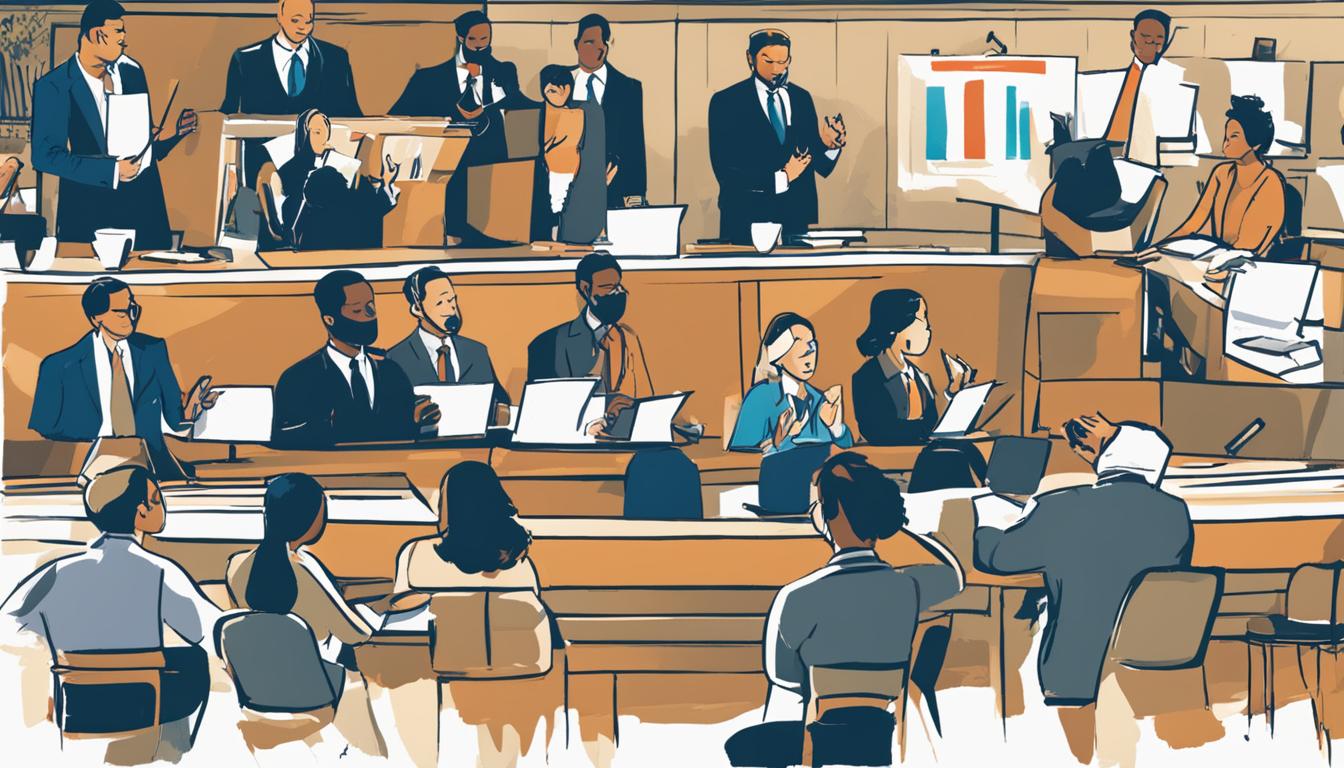
Welcome to our comprehensive guide on the various types of speeches . In the realm of public speaking, speakers utilize different speech styles to effectively communicate with their audiences. Each type of speech serves a unique purpose and employs distinct techniques. By understanding these speech styles, you can enhance your communication skills and engage your listeners more effectively.
Key Takeaways:
- Informative speeches provide new information on objects, events, processes, and concepts.
- Persuasive speeches aim to change thinking or behavior through emotional or logical appeals.
- Demonstrative speeches educate and teach through demonstrations of specific skills or processes.
- Special occasion speeches are given during specific events or celebrations to honor someone or something.
- Entertaining speeches focus on providing enjoyment to the audience through humor and engaging content.
Table of Contents
Informative Speeches
Informative speeches are a powerful tool for sharing new information and knowledge with an audience. These speeches aim to educate and enlighten, providing valuable insights into various subjects. There are different types of informative speeches , each focusing on a specific aspect of information delivery.
Speeches about Objects
Speeches about objects are designed to provide detailed information about tangible things that can be experienced with the senses. These speeches may explore the history , characteristics, or uses of specific objects, allowing the audience to gain a deeper understanding of their nature.

Speeches about Events
Speeches about events inform the audience about current or past happenings. Whether it’s a historical event, a social movement, or a significant milestone, these speeches aim to educate the audience about the event’s context, impact, and importance.
Speeches about Processes
Speeches about processes provide step-by-step instructions or explanations on how to do something. Whether it’s a cooking recipe, a DIY project, or a professional technique, these speeches break down complex processes into manageable steps, helping the audience learn and apply new skills.
Speeches about Concepts
Speeches about concepts delve into intangible ideas and notions. They explore abstract concepts such as love, justice, success, or happiness, offering a deeper understanding and new perspectives on these topics. These speeches often challenge the audience’s preconceived notions and encourage critical thinking.
Informative speeches play a vital role in sharing knowledge and expanding horizons. By providing valuable information on a wide range of subjects, these speeches empower the audience to learn, grow, and explore the world around them.
Persuasive Speeches
Persuasive speeches are a powerful tool in influencing and changing the thinking or behavior of an audience. Speakers employ various techniques to make a persuasive case, including emotional appeal and logical appeal . Emotional appeal aims to evoke strong emotions in the audience, such as sympathy, empathy, or excitement, to create a connection and influence their perception. On the other hand, logical appeal relies on presenting evidence, facts, and reasoning to logically convince the audience of a particular viewpoint or course of action.
When using emotional appeal in persuasive speeches , speakers often incorporate personal anecdotes, powerful stories , or vivid descriptions to create a deep emotional impact. By appealing to the audience’s emotions, speakers can tap into their values , beliefs, and desires, making them more receptive to their message. Logical appeal , on the other hand, relies on presenting well- structured arguments supported by facts, statistics, and expert opinions. This appeals to the audience’s rational thinking and analytical abilities, encouraging them to critically evaluate the information presented.
Persuasive speeches are commonly used in various contexts, such as sales and advertising, advocacy and activism, and political campaigns. They play a crucial role in influencing public opinion, shaping attitudes, and driving behavioral change. Whether it’s convincing consumers to buy a product, persuading individuals to support a cause, or rallying voters during an election, persuasive speeches have the power to effectively communicate a message and inspire action.
“The power of persuasion lies in the ability to touch hearts and minds, making a lasting impact on the audience.”
Effective persuasive speakers strike a balance between emotional and logical appeals, recognizing that different individuals respond to different approaches. By understanding their audience and tailoring their speeches accordingly, speakers can maximize their persuasive impact and bring about meaningful change.
Demonstrative Speeches
Demonstrative speeches are a fascinating type of speech that not only provides information but also includes a demonstration of how to do something. These speeches aim to teach the audience a specific skill or process, making them highly interactive and engaging. By including a demonstration, speakers can effectively convey their knowledge and expertise, ensuring that the audience gains a practical understanding of the topic.
Whether it’s learning how to start your own blog, bake a cake, or write a speech, demonstrative speeches offer a hands-on learning experience. The combination of verbal explanation and visual demonstration helps the audience to better understand and retain the information being presented. It allows them to observe the speaker’s actions in real-time, enabling them to grasp the nuances and intricacies of the skill or process being taught.
“Demonstrative speeches provide a unique learning opportunity by bridging the gap between theory and practice. They empower the audience to actively participate, ask questions, and gain firsthand experience in the topic at hand.”
Moreover, demonstrative speeches are not limited to specific subjects or fields. They can cover a wide range of topics, from practical skills like cooking and crafting to complex processes like programming and project management. The versatility of demonstrative speeches makes them suitable for various educational, professional, or recreational settings.
Teaching Through Demonstration
One of the key advantages of demonstrative speeches is their ability to teach through demonstration. By combining verbal explanations with practical examples, speakers can effectively convey their knowledge and skills to the audience. The visual component of the demonstration helps to enhance understanding and retention, as the audience can observe the step-by-step process in action. This hands-on learning experience creates a more immersive and engaging environment, allowing the audience to learn and apply the knowledge in real-time.
In conclusion , demonstrative speeches provide a unique and interactive way to teach the audience something new. By including a demonstration, speakers can bridge the gap between theory and practice, allowing the audience to learn through observation and participation. Whether it’s acquiring a practical skill or understanding a complex process, demonstrative speeches offer an engaging and effective learning experience.
Special Occasion Speeches
Special occasion speeches are an important part of various events and celebrations . These speeches are crafted to commemorate or honor someone or something significant. They add a personal touch and create a memorable experience for both the speaker and the audience.
One of the most common types of special occasion speeches is a toast. Toasts are given at weddings, birthdays, anniversaries, and other celebratory gatherings. They offer an opportunity to express heartfelt wishes, share memories, and raise a glass in honor of the occasion.
Commemorations are another form of special occasion speeches that pay tribute to a person, an event, or an idea. These speeches are often delivered on memorable dates or during commemorative events. They serve as a way to remember and honor the past , while also inspiring hope for the future .
“A toast to love, laughter, and a lifetime of happiness. May your journey together be filled with joy and cherished moments.”
Celebrations provide a platform for special occasion speeches that bring people together in a spirit of joy and festivity. These speeches add meaning and significance to the occasion, highlighting the accomplishments and milestones achieved. Whether it’s a graduation ceremony, a retirement party, or an awards ceremony, the speech sets the tone for celebration and reflection.
Special occasion speeches hold a special place in our hearts and create lasting memories. They add depth and meaning to significant events and allow us to express our emotions in a thoughtfully crafted manner.
Entertaining Speeches
Entertaining speeches , also known as after-dinner speeches , are a delightful way to engage and captivate an audience. These speeches are specifically designed to provide enjoyment and leave a lasting impression. With a touch of humor and engaging content, entertaining speeches aim to make the audience laugh, relax, and have a good time.
“Laughter is the best medicine,” they say, and entertaining speeches are no exception. They often include witty anecdotes, funny stories , and amusing experiences that create a lighthearted atmosphere. By incorporating humor into their speeches, speakers can connect with the audience on a deeper level and leave them with a sense of joy and fulfillment.
After-dinner speeches are typically given at social or festive events, such as banquets, galas, or charity dinners. They provide a break from the formalities of the occasion and offer an opportunity for attendees to relax and enjoy themselves. The light-hearted nature of entertaining speeches makes them a perfect addition to any social gathering where audience enjoyment is a priority.
Engaging the audience through humor
Humor plays a crucial role in entertaining speeches. It helps to establish a connection between the speaker and the audience, creating a relaxed and enjoyable atmosphere. By using funny anecdotes, relatable stories, or clever wordplay, speakers can engage the audience and keep them entertained throughout the speech.
- Use humorous anecdotes: Sharing personal stories that have a humorous twist can instantly grab the attention and evoke laughter from the audience.
- Employ comedic timing: The delivery of jokes and humorous lines is just as important as the content itself. Properly timed punchlines can enhance the comedic effect and create a memorable experience for the audience.
- Inject light-hearted banter: Interacting with the audience through light-hearted banter or playful exchanges can make the speech more interactive and entertaining.
By incorporating these techniques into their speeches, speakers can ensure that the audience leaves with a smile on their faces and fond memories of an enjoyable experience.
Motivational Speeches
Motivational speeches have the power to inspire , motivate , and empower individuals to reach their full potential. These speeches are designed to ignite a spark within the audience, encouraging them to take action and overcome challenges. Through uplifting words and personal stories, motivational speakers create a sense of belief and possibility. Whether delivered in educational settings, conferences, or personal development events, these speeches have the ability to leave a lasting impact on the lives of those who listen.
Motivational speeches aim to inspire individuals by highlighting the power of resilience , determination, and self-belief. They often share personal anecdotes of triumph over adversity, showcasing the speaker’s own journey of overcoming obstacles and achieving success. By hearing stories of others who have faced challenges and come out stronger, the audience is motivated to persevere in their own pursuits.
To motivate and empower, these speeches often offer practical advice and actionable steps that individuals can implement in their lives. The speakers may provide strategies for goal setting , time management, or personal growth. By providing specific tools and techniques, motivational speeches empower the audience to take control of their own destiny and make positive changes.
“The only way to do great work is to love what you do.” – Steve Jobs
In summary, motivational speeches have the power to inspire, motivate , and empower individuals to overcome challenges and achieve their goals. Through personal stories, practical advice, and uplifting words, these speeches leave a lasting impact on the audience, encouraging them to take action and reach their full potential.
Impromptu Speeches
Impromptu speeches are a unique form of public speaking that requires speakers to think on their feet and deliver a speech spontaneously. These speeches are often delivered in situations where immediate responses or remarks are needed, such as panel discussions, debates, or impromptu speaking contests. The key characteristic of impromptu speeches is their unprepared nature, which adds an element of spontaneity and challenge for the speaker.
Unlike other types of speeches that require extensive preparation and practice, impromptu speeches rely on the speaker’s ability to think quickly and articulate their thoughts effectively. This type of speech can be particularly challenging for those who are not comfortable with public speaking or have a fear of improvisation. However, with practice and experience, individuals can develop the skills necessary to deliver compelling impromptu speeches.
One of the key advantages of impromptu speeches is that they allow for genuine and immediate responses. Speakers have the freedom to express their thoughts and opinions in real-time, without the constraints of a pre-written script. This can create a sense of authenticity and spontaneity that can engage and captivate the audience. Impromptu speeches also provide an opportunity for individuals to demonstrate their critical thinking skills, as they must quickly gather their thoughts, organize their ideas, and deliver a coherent speech on the spot.
Extemporaneous Speeches
Extemporaneous speeches are prepared speeches that offer a balance between structure and flexibility . These speeches are carefully planned and crafted beforehand, but allow the speaker to adapt and modify the content based on the audience’s response. The key to delivering a successful extemporaneous speech is to have a solid understanding of the topic and the ability to engage in interactive discussions.
Unlike impromptu speeches, which are delivered without prior preparation, extemporaneous speeches provide speakers with the advantage of careful planning and organization. They allow the speaker to have a well- structured presentation while retaining the flexibility to adjust their delivery based on the immediate context.
Extemporaneous speeches are commonly seen in academic or professional settings, such as conferences or presentations. These speeches often involve a Q&A session, enabling speakers to respond to questions and address the specific interests of the audience. This interactive element adds depth and engagement to the speech, fostering a dynamic and informative exchange between the speaker and the audience.
“Extemporaneous speeches allow speakers to strike a balance between preparation and spontaneity. With a well-researched and structured presentation, speakers can effectively communicate their ideas while remaining adaptable to the needs and interests of the audience.”
The Benefits of Extemporaneous Speeches
There are several benefits to delivering extemporaneous speeches. Firstly, the careful preparation and planning enable speakers to present a clear and cohesive message. This ensures that the audience receives information in a logical and organized manner.
Secondly, the flexibility of extemporaneous speeches allows speakers to tailor their content and delivery to suit the specific audience. By engaging in interactive discussions and adapting their speech on the fly, speakers can address the unique interests and concerns of the listeners, enhancing their overall connection and impact.
Lastly, the interactive nature of extemporaneous speeches encourages audience participation and fosters a sense of engagement. This creates a more dynamic and memorable experience for the listeners, increasing the likelihood that they will retain and apply the information shared in the speech.
Commemorative Speeches
Commemorative speeches hold a special place in public speaking as they provide an opportunity to pay tribute and offer praise to individuals, institutions, events, ideas, or places. These speeches are a celebration of core values that are important to society, such as beauty, loyalty, wisdom, kindness, and courage. Commemorative speeches serve as a powerful reminder of the impact and significance of these values in our lives.
One of the most common types of commemorative speeches is the eulogy, which is delivered at a funeral or memorial service to honor and remember the life of a deceased loved one. Eulogies offer comfort to grieving family and friends while celebrating the accomplishments, character, and legacy of the individual. This type of commemorative speech provides an opportunity to reflect on the values and qualities that made the person special and encourages others to embrace those values in their own lives.
Another example of a commemorative speech is the award acceptance speech. When receiving an award, whether it’s for professional achievements, community service, or artistic endeavors, the recipient has the opportunity to share their gratitude, inspiration, and motivation with the audience. These speeches not only express appreciation for the recognition but also highlight the values and principles that guided the recipient in their journey towards success.
Commemorative speeches can also take the form of wedding toasts or speeches of goodwill. In these instances, speakers have the chance to express their love, admiration, and support for the couple or the occasion. These speeches celebrate the values of love, commitment, friendship, and joy, bringing everyone together in a spirit of unity and celebration.
Commemorative speeches have the power to inspire, uplift, and unite people. Through words that honor and praise , these speeches remind us of the values we hold dear and the importance of celebrating individuals, events, and ideas that shape our lives.
Language and Future in Commemorative Speeches
Commemorative speeches hold a unique power to captivate and inspire audiences, combining language techniques such as storytelling, illustrations , and figurative language to convey the speaker’s experience. These techniques not only engage the audience on an emotional level but also create a lasting impact. Through the art of language , commemorative speeches bridge the gap between the past, present , and future , offering hope and optimism for what lies ahead.
Storytelling is a fundamental aspect of commemorative speeches, allowing speakers to connect with their audience on a personal level. By sharing anecdotes and narratives, speakers can draw upon shared experiences and tap into the emotions of the audience. These stories serve as powerful illustrations , enabling the audience to relate to the speaker’s message and forge a deeper connection. Through the use of vivid imagery and descriptive language , the audience is transported into the world of the speaker’s experiences.
“Language has the power to inspire, to heal, and to create a vision of a better tomorrow. It is through our words that we shape the future and ignite hope in the hearts of those who listen.”
Figurative language is another tool utilized in commemorative speeches to evoke powerful imagery and emotions. Metaphors, similes, and other forms of figurative language add depth and resonance to the speaker’s message, allowing the audience to visualize abstract concepts and ideas. By using figurative language, speakers can express complex emotions and convey their deepest thoughts in a way that resonates with the audience.
The Power of Hope: Connecting Past, Present, and Future
Commemorative speeches also have the remarkable ability to link the past, present , and future, instilling a sense of hope in the hearts of the listeners. By acknowledging the accomplishments and challenges of the past, speakers can inspire others to carry the torch forward and build a brighter future. These speeches remind us that while we honor the past, it is in the present moment that we have the power to shape the future.
Language, stories, illustrations , and figurative language are the building blocks of powerful commemorative speeches. They create a profound impact, connecting the speaker with the audience and leaving a lasting impression on those fortunate enough to listen. Through the art of language, commemorative speeches inspire hope, foster unity, and remind us of the power of our collective journey.
In conclusion , the world of public speaking offers a diverse range of speech types, each with its own unique characteristics and purpose. Informative speeches provide new knowledge, persuasive speeches aim to change minds, and demonstrative speeches teach through practical demonstrations.
Special occasion speeches help us celebrate and commemorate important events, while entertaining speeches bring joy and laughter to the audience. Motivational speeches inspire and empower, impromptu speeches require quick thinking, and extemporaneous speeches offer the perfect balance between structure and flexibility.
And let’s not forget about commemorative speeches, which pay tribute to individuals and ideas while celebrating core values. Each type of speech plays a vital role in effective communication, allowing speakers to connect with their audience, convey information, and inspire change.
In a world where words hold immense power, understanding the various types of speeches equips speakers with the tools to leave a lasting impact. By recognizing the power of language and the unique characteristics of each speech type, speakers can craft their messages effectively, engage their audience, and create meaningful connections.
What are the different types of speeches?
The different types of speeches include informative speeches, persuasive speeches, demonstrative speeches, special occasion speeches, entertaining speeches, motivational speeches, impromptu speeches, and extemporaneous speeches.
What is the purpose of informative speeches?
Informative speeches are delivered to provide the audience with new information and knowledge on various topics.
How do persuasive speeches aim to convince the audience?
Persuasive speeches aim to change the audience’s thinking or behavior by using emotional appeals or logical appeals.
What is the difference between informative speeches and demonstrative speeches?
While both types of speeches provide information, demonstrative speeches also include a demonstration of how to do something.
What are special occasion speeches?
Special occasion speeches are given during specific events or celebrations to commemorate or honor someone or something.
What is the goal of entertaining speeches?
Entertaining speeches aim to provide pleasure and enjoyment to the audience through humor and engaging content.
How do motivational speeches inspire and empower the audience?
Motivational speeches share personal stories, offer practical advice, and provide encouragement to help the audience take action and achieve their goals.
What are impromptu speeches?
Impromptu speeches are delivered without prior preparation or practice and require the speaker to think on their feet.
How are extemporaneous speeches different from impromptu speeches?
Extemporaneous speeches are prepared but allow the speaker flexibility to adapt and modify the content based on the audience’s response.
What are commemorative speeches?
Commemorative speeches pay tribute or praise to a person, institution, event, idea, or place.
How do commemorative speeches use language and storytelling?
Effective commemorative speeches utilize storytelling, illustrations, and figurative language to engage the audience and convey the speaker’s experience. They also provide hope for the future by linking the past, present, and future.
Related Posts
![type of speech in communication Ray Dalio Quotes [Principles, Life, Investment]](https://tagvault.org/wp-content/uploads/2023/04/Screen-Shot-2023-04-19-at-7.57.49-PM.png)
307+ Ray Dalio Quotes [Principles, Life, Investing, Politics]

27+ Therapy Activities for Teens (Helpful Ideas)
Learn The Types
Learn About Different Types of Things and Unleash Your Curiosity
Types of Speeches: A Guide to Different Styles and Formats
Speeches are a powerful way to communicate ideas, inspire people, and create change. There are many different types of speeches, each with its own unique characteristics and formats. In this article, we’ll explore some of the most common types of speeches and how to prepare and deliver them effectively.
1. Informative Speech
An informative speech is designed to educate the audience on a particular topic. The goal is to provide the audience with new information or insights and increase their understanding of the topic. The speech should be well-researched, organized, and delivered in a clear and engaging manner.
2. Persuasive Speech
A persuasive speech is designed to convince the audience to adopt a particular viewpoint or take action. The goal is to persuade the audience to agree with the speaker’s perspective and take action based on that belief. The speech should be well-researched, organized, and delivered in a passionate and compelling manner.
3. Entertaining Speech
An entertaining speech is designed to entertain the audience and create a memorable experience. The goal is to engage the audience and make them laugh, cry, or think deeply about a particular topic. The speech can be humorous, inspirational, or emotional and should be delivered in a lively and engaging manner.
4. Special Occasion Speech
A special occasion speech is designed for a specific event or occasion, such as a wedding, graduation, or retirement party. The goal is to celebrate the occasion and honor the people involved. The speech should be personal, heartfelt, and delivered in a sincere and respectful manner.
5. Impromptu Speech
An impromptu speech is delivered without any preparation or planning. The goal is to respond quickly and effectively to a particular situation or question. The speech should be delivered in a clear and concise manner and address the topic at hand.
In conclusion, speeches are an important way to communicate ideas, inspire people, and create change. By understanding the different types of speeches and their unique characteristics and formats, individuals can prepare and deliver successful speeches that are engaging, informative, and memorable.
You Might Also Like:
Patio perfection: choosing the best types of pavers for your outdoor space, a guide to types of pupusas: delicious treats from central america, exploring modern period music: from classical to jazz and beyond.

- Nashville State Community College
- Research Guides
Speech Communications
- Types of Speeches
- Get Started
- Find Websites
- Find Articles
- Speech Anxiety
- MLA Citations
- Research Help
- Find a Tutor This link opens in a new window
Persuasive Speeches
A persuasive speech attempts to influence or reinforce the attitudes, beliefs, or behavior of an audience. This type of speech often includes the following elements:
- appeal to the needs of the audience
- appeal to the reasoning of the audience
- focus on the relevance of your topic to the audience
- fit the speech to the audience - ensure they understand the info
- make yourself credible by demonstrating your expertise
Watch out for logical fallacies in developing your argument:
- ad hominem argument = attacking an opponent rather than their argument
- bandwagoning = using popular opinion as evidence
- begging the question = using circular reasoning
- either-or fallacy = the argument is structured as having either one answer or another
- hasty generalization = taking one instance as a general pattern
- non sequitur = aka: it does not follow ; your conclusions are not connected to the reasoning
- red herring fallacy = using irrelevant info in the argument
- slippery slope = arriving at a truth by supposing a series of possible events
- Persuasive Speech Topic Ideas
Informative Speeches
An informative speech is one that enlightens an audience. These types of speeches can be on a variety of topics:
A good informative speech will:
- define terms to make the information clearer
- use descriptions to help the audience form a mental picture
- incorporate a demonstration
- explain concepts in-depth for greater understanding
Informative speech example from Bill Gates: Mosquitos, malaria and education
- Informative Speech Ideas
- << Previous: Get Started
- Next: Find Websites >>
- Last Updated: Jul 16, 2024 3:17 PM
- URL: https://nscc.libguides.com/speech

IMAGES
VIDEO
COMMENTS
Different types of speech are used depending on the context, audience, and purpose of communication. Understanding these types helps in selecting the appropriate mode of expression and achieving the desired impact.
Learn what a speech is and the various types of speeches you can give. Use the list of tips to help you conduct better research for your upcoming speech.
There are four main types of speeches or types of public speaking. Informative. Demonstrative. Persuasive. Special occasion or Entertaining. To harness their power a speaker needs to be proficient in all of them: to understand which speech type to use when, and how to use it for maximum effectiveness. What's on this page:
The four types of speeches are manuscript, memorized, extemporaneous, and impromptu. Our aim is to acquaint you with these four different modes of delivery, to provide suggestions for when you are asked to make impromptu remarks, and then to focus most your time on the preparation, practice, and presentation of extemporaneous speeches.
Types of Speeches (Communication Styles) November 1, 2023 Tag Vault. Welcome to our comprehensive guide on the various types of speeches. In the realm of public speaking, speakers utilize different speech styles to effectively communicate with their audiences. Each type of speech serves a unique purpose and employs distinct techniques.
Discuss the three main types of speeches. Discuss the importance of differentiating between the three. Speeches have traditionally been seen to have one of three broad purposes: to inform, to persuade, and— Well, to be honest, different words are used for the third kind of speech purpose: to inspire, to amuse, to please, to delight, or to ...
The four basic types of speeches are: to inform, to instruct, to entertain, and to persuade. These are not mutually exclusive of one another. You may have several purposes in mind when giving your presentation. For example, you may try to inform in an entertaining style.
Learn about the most common types of speeches, including informative, persuasive, and entertaining speeches. Discover their unique characteristics and formats to help you prepare and deliver a successful speech.
Crafting a successful speech involves understanding its types such as informative, persuasive, demonstrative, and special occasion speeches. Each type serves a unique purpose from educating listeners about new topics to convincing them to adopt new viewpoints.
This guide will help speech communication students navigate through informative and persuasive speeches, as well as speech anxiety.